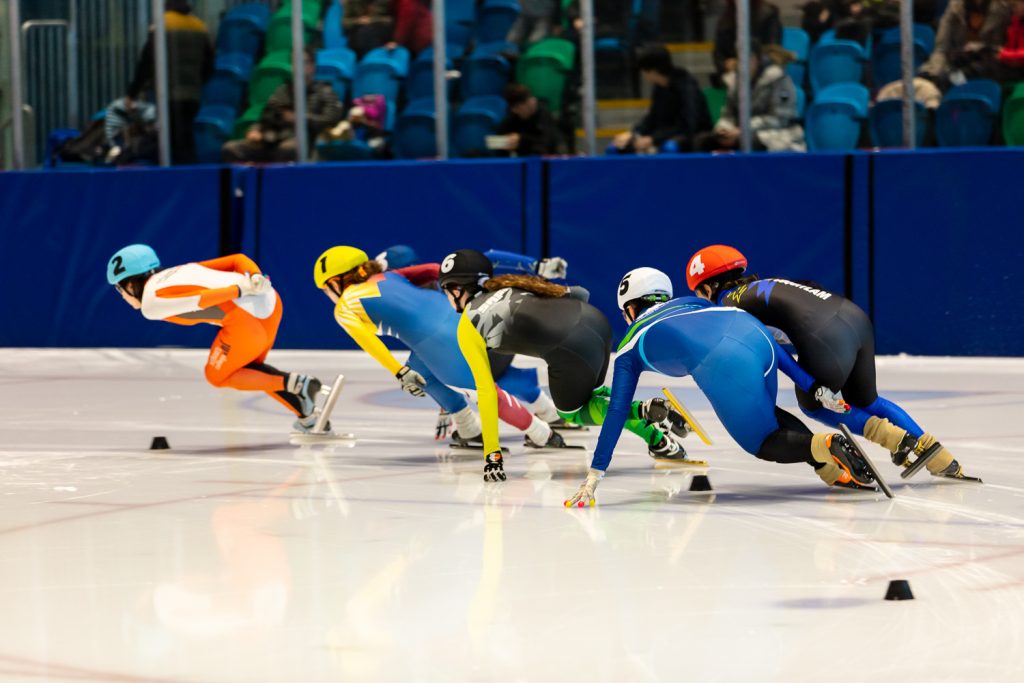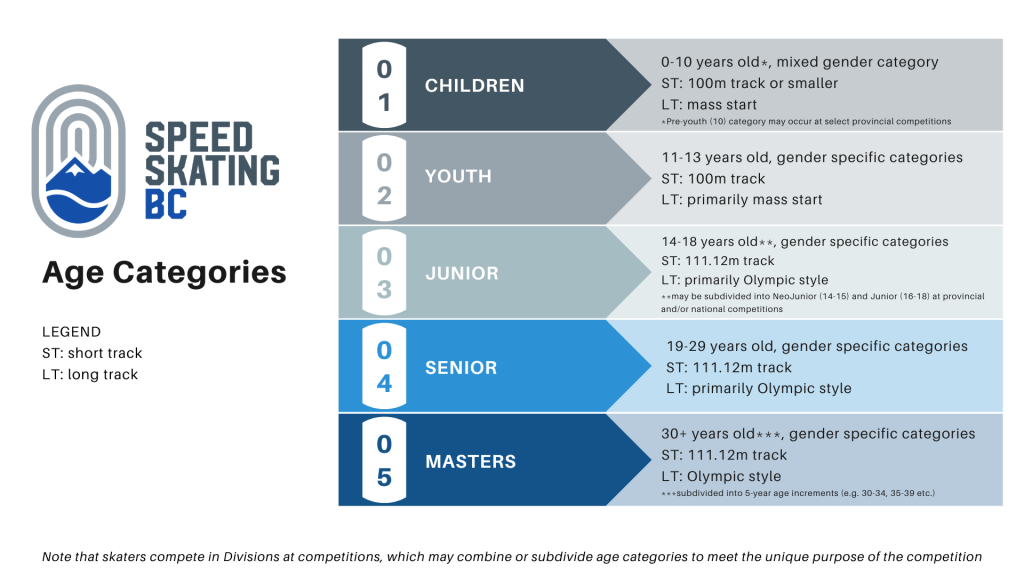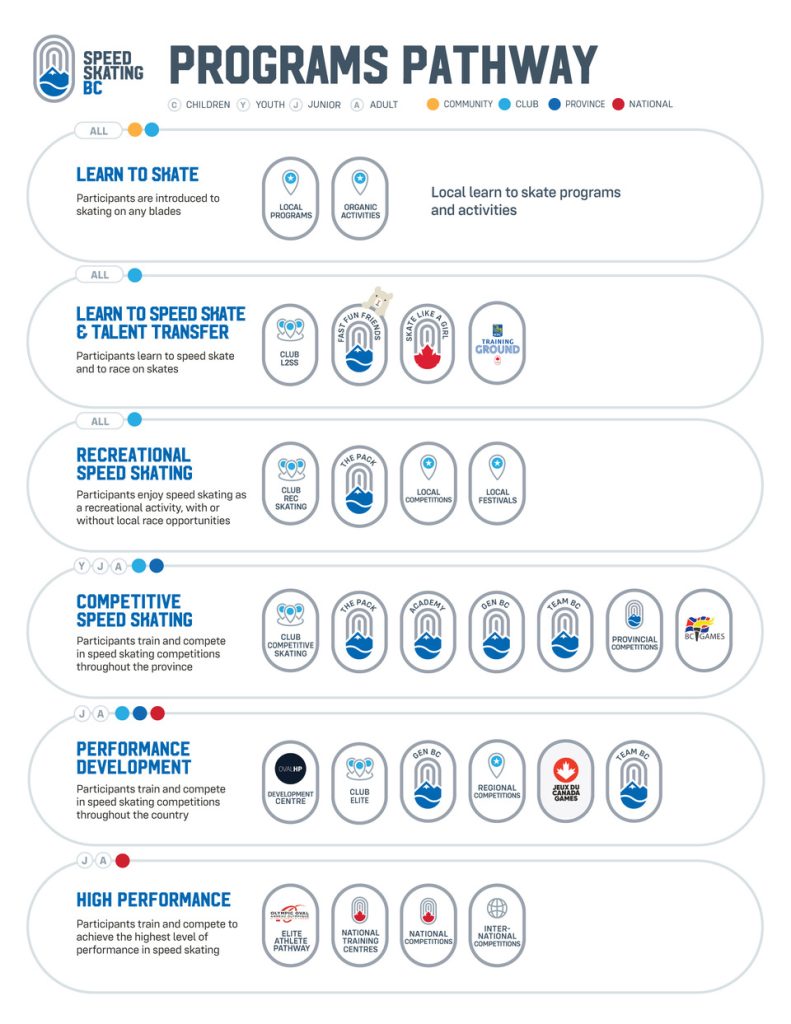SKATE FAST
Membership

association membership
All speed skaters in British Columbia are registered to both Speed Skating Canada and Speed Skating BC. Membership is required to participate, compete, volunteer, or try speed skating. Membership categories are listed below.
Prices below are reflective of the 2023-2024 season.
NATIONAL
-
Speed Skating Canada
-
Speed Skating BC
PROVINCIAL
-
Speed Skating Canada
-
Speed Skating BC
CLUB
-
Speed Skating Canada
-
Speed Skating BC
INTRODUCTORY
-
Speed Skating Canada
-
Speed Skating BC
TRY SPEED SKATING
-
Speed Skating Canada
-
Speed Skating BC
COACH
-
Speed Skating Canada
-
Speed Skating BC
Official
-
Speed Skating Canada
-
Speed Skating BC
Volunteer
-
Speed Skating Canada
-
Speed Skating BC
Speed Skating Pathway
All skaters have a place within Speed Skating BC! Our programs and competitions use age categories for member clarity and ease of communication. The SSBC Age Categories match the national (Speed Skating Canada) age categories and were developed based on Long Term Athlete Development principles, including: holistic development of the skater (physical, intellectual, social), an early focus on physical literacy, and sport for life opportunities.
Our SSBC Programs Pathway showcases the “right programming at the right time”. We offer or partner to deliver programs to skaters across the Long Term Athlete Development spectrum, from Club Learn to Speed Skate, to GenBC programming for our Performance Development skaters, to PACK programming to keep our Masters skaters engaged for life.
Disciplines
Short Track
Long Track
Short track speed skating takes place on a 111.12m (or 100m) oval track on a rink (Olympic size or NHL size). Because the corners are tight and it can be difficult for skaters to maintain control, the boards must be covered by protective mats of polyurethane foam at least 20 cm thick with a minimum height of 1 m. The mats are covered with a water-resistant and cut-resistant material and they must be attached to the boards as well as to each other. Skaters race pack-style where the first competitor to cross the line wins.
Racing in pairs, counterclockwise, on two lanes of a 400m oval track, the skaters change lanes every lap in order to equalize the distance covered. The skater in the outside lane has the right-of-way at the crossover if the skaters arrive at the same time. Racing includes Olympic Style, mass start (pack-style), and team pursuit.
Equipment
head protection
A helmet. Ski/snowboard, hockey or roller sport helmets are all acceptable. Bike helmets cannot be used because the large vents allow skate blades to pass through. Many clubs will have spare helmets for use.
Neck protection
A neck guard- bib style. Many clubs will have spare neck guards for use.
hand protection
Cut-proof gloves or mittens. Ski mitts or leather gloves are best. Hockey gloves are also acceptable.
Ankle Protection
Well-fitting, tall socks. Socks that are too short can cause skin irritation and blisters due to friction against the inside of the skates. A cut and puncture resistant anklet must be worn on both legs, covering the legs from the tops of the boots to 10 cm above the tops of the boots.
Skate blades
The rear and front tips of all skate blades must be rounded to a minimum radius of 1cm.
eye protection
Shatter-resistant clear glasses or a complete visor are required for all skaters. All glasses must be held in place by a strap.
rest of body protection
Comfortable, athletic-style long sleeve top and pants. A skin suit is not required at the introductory level. As a skater progresses in the sport and begins to compete at national-level competitions, they will require a skin suit with cut-proof material meeting or exceeding ISU standards.
knee protection
Knee pads. Soft, volleyball style pads are preferred, although plastic roller sport pads are also acceptable. If possible, plastic pads should be worn underneath the skater’s pants. Hockey knee/shin pads are acceptable, but may limit the skater’s movement. Knee pads that are built-in to a skin suit are also acceptable.
Shin Protection
Shin guards. Hard soccer shin guards are best, but hockey knee/shin pads are also acceptable.



